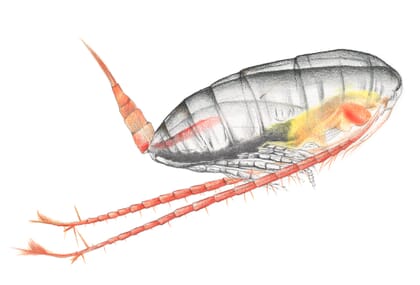
It is a key component in the food web of the North Atlantic, providing sustenance for a variety of marine organisms including fish, shrimp, and whales. © Laura Hidalgo Lopez
Andfjord Salmon is the first salmon farmer in the world that utilises a commercially developed feed that contains Calanus.
“Our ambition is to develop the world’s most fish friendly and sustainable aquaculture facility of its kind. Having our own specially designed feed, with unique ingredients from a local supplier, is another important building block towards realising this ambition,” said Martin Rasmussen, CEO of Andfjord Salmon, in a press release.
The company released the first cohort of salmon smolts into their land-based flow-through facility on 25 June.
“The fish has settled quickly and has already demonstrated a healthy appetite, which continues to improve daily. Fish mortality rate is extremely low, so it has been a promising start,” Rasmussen said.
In February this year, Andfjord Salmon asked Skretting to develop a feed that is specifically tailored to Andfjord Salmon’s flow-through technology to ensure optimal water quality, fish welfare and growth conditions. The resulting feed has been named “Calanus Plus by Andfjord Salmon”.
It is the first salmon feed that utilises the zooplankton Calanus finmarchicus as raw material ingredient. The feed also contains algae oil as an alternative to marine fish oil.
“Calanus finmarchicus is nature's own ‘starter’ feed. It is a natural prey that is biologically adapted to provide optimal nutrition for fish. Adding Zooca hydrolysate made from Calanus finmarchicus to the feed will be very useful to stimulate the fish's appetite in the transition to seawater. We look forward to cooperating with Zooca (Calanus AS) and Andfjord Salmon to realise the vast untapped potential that Calanus finmarchicus represents,” said Mads Martinsen, director of product development and sustainability at Skretting.
The Calanus is being supplied to Skretting by Zooca (Calanus AS), which processes Calanus finmarchicus at its facility at Sortland in Vesterålen, close to Andfjord Salmon’s site at Kvalnes. Over the last 20 years it has researched, studied and developed technology to sustainably harvest and process this zooplankton species, which is one of the most numerous animal species on the planet, with an annual reproduction of approximately 300 million tonnes, and it is Norway's largest harvestable and renewable marine resource. Today the company only harvests approximately 0.0005 percent of the total volume annually.
“By sustainably harnessing high-performing, high-quality nutrients from Calanus finmarchicus, there is a large potential to improve long-term human health and ensure superior animal nutrition around the globe. We are delighted to secure this commercial breakthrough within salmon feed together with Andfjord Salmon and Skretting,” said Hogne Abrahamsen, international account director at Zooca.




